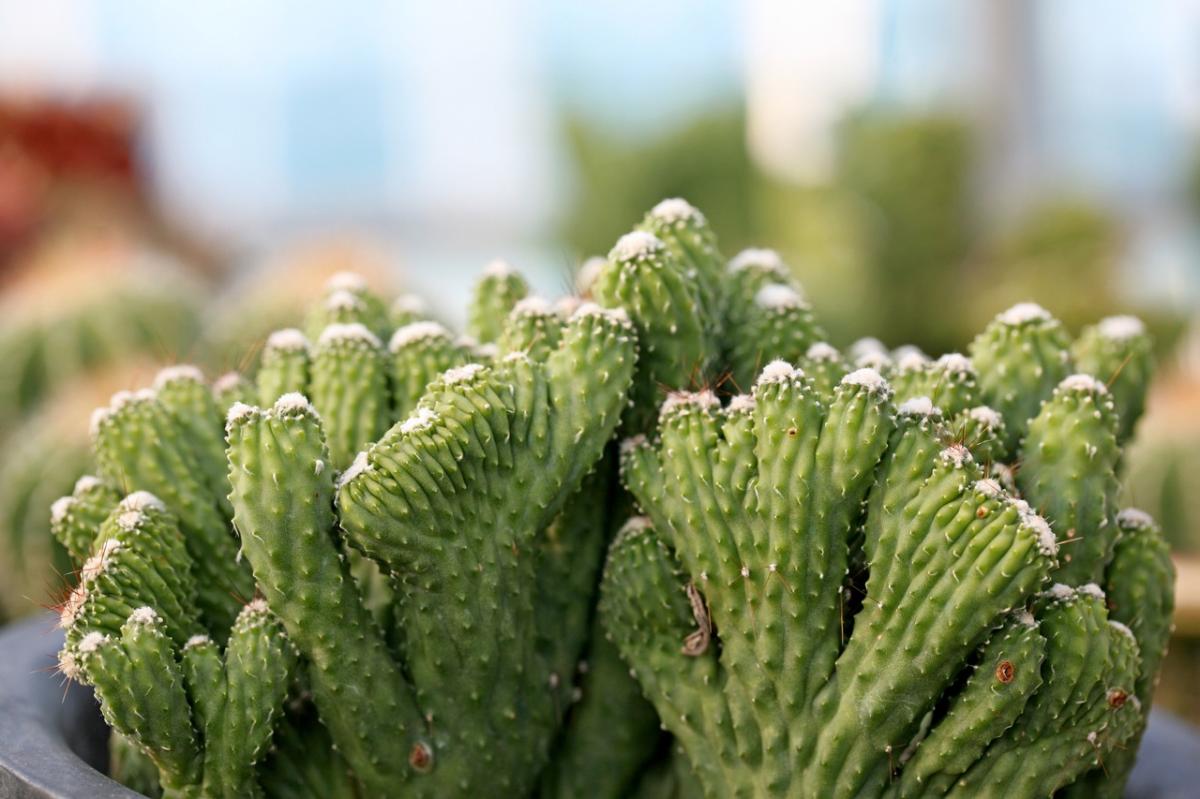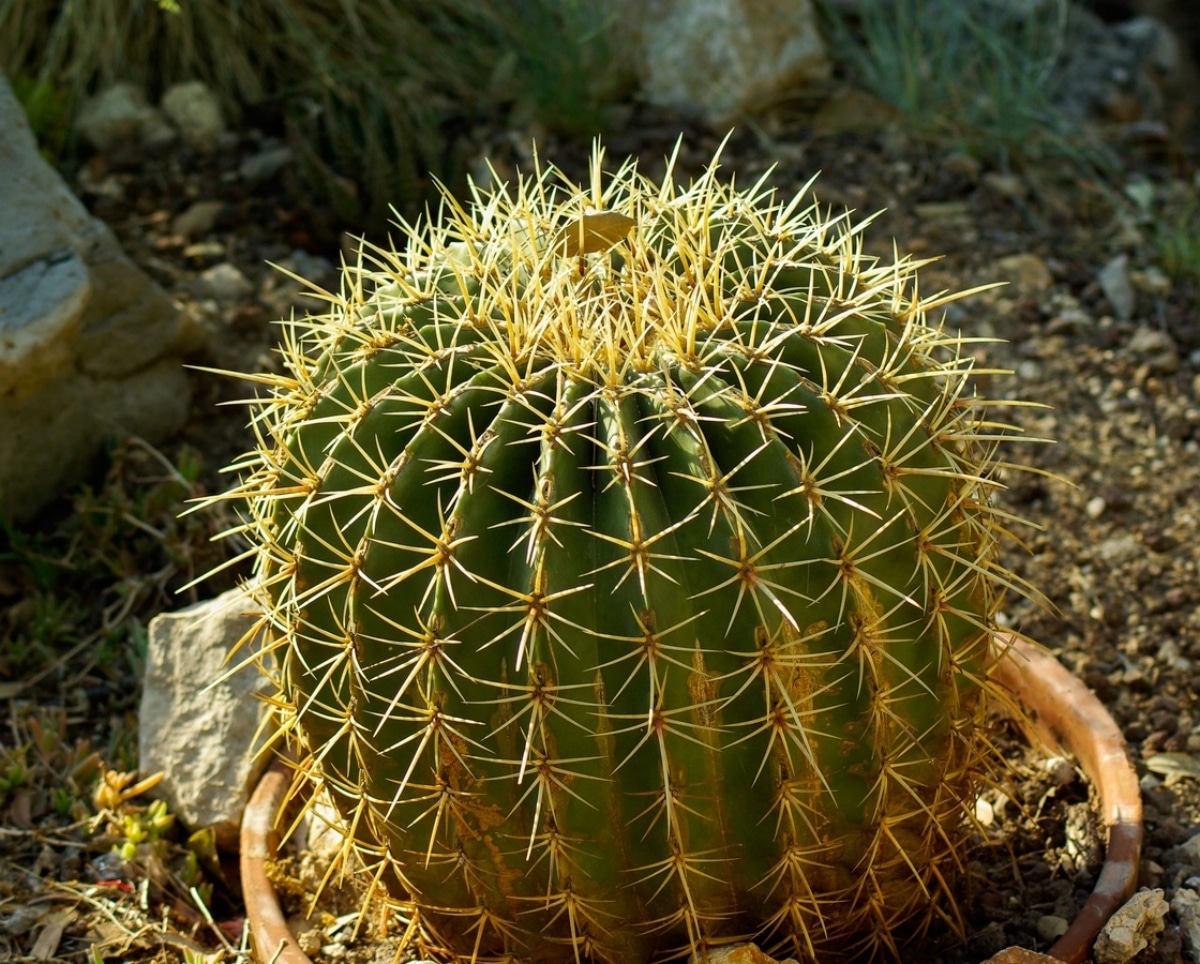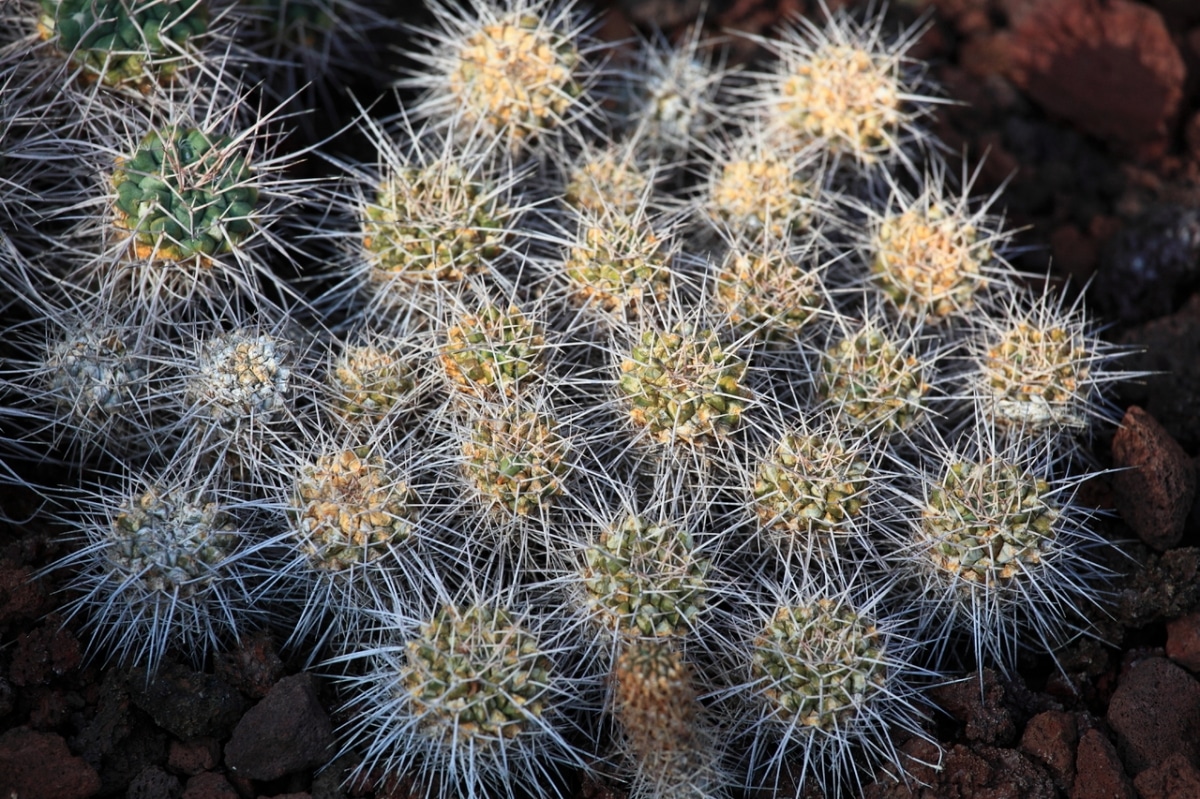
Would you like to know how to recover a cactus with fungi? I anticipate that it may take longer than desired, since these are organisms that, once they enter the interior of the plant, advance very quickly while at the same time weakening it.
Although if the symptoms are detected in time, sometimes it can be saved. So let's first see what those signs are that we should pay attention to, and then what measures we should take to recover our beloved cactus.
How do I know if my cactus has a fungal infection?

There are a series of symptoms that will tell us that something is happening to the plant:
- softens, you can start from the bottom and work your way up. In severe cases, if it is pressed inward, we can feel an unpleasant odor.
- Thorns fall off easily. This happens because the cacti that have fungus have almost always (if not always) either received more water than they need (either rain or irrigation), and/or because they grow in soil that retains too much moisture. humidity. And it is that excess water (or humidity) favors the spread of fungi.
- spots will appear brown, blackish or orange, or gray mold.
What to do to recover it?
Measurements will vary a bit depending on how severe the cactus is. That is to say, if it does not have stains or it does have but they are very few and it is NOT yet soft, generally if the substrate is changed it will be enough. Let's see how to do it step by step:
- First, we will prepare the substrate that we will put on it: it can be a mixture of peat with perlite in equal parts, but we recommend using small or medium grain pumice as it is a lighter material, and it dries faster, something that will come in handy better to the cactus. you can buy it here.
- Then, we will extract the plant from the pot, and very carefully, with our hands, we will remove the substrate. We will also take the opportunity to take a look at the roots, and if there are any that are black, we will cut them with scissors previously disinfected with pharmacy alcohol or a little soap.
- Then, we will apply polyvalent fungicide to the entire cactus, also to its roots. We will use rubber gloves (such as those used to wash dishes for example) to avoid direct contact with the product. This For example, it is an envelope of 50 grams that has to be diluted in 15 liters of water.
- Finally, we will plant it in a new pot with the substrate mentioned before.
And from here, it will be placed in a place where there is a lot of light, but not direct. After a week we can resume watering, but always bearing in mind that the substrate must be allowed to dry completely between one watering and the next. If pumice is used, since it can be difficult to tell if it is wet or not, it should be watered more or less once or twice a week in summer, and once every 2-3 weeks the rest of the year, depending on whether it rains and the conditions. temperatures there are.
But What do we have to do if the cactus is very soft?
To nip the root problem, we must take a previously disinfected cuttex, and we will cut everything that is infected. It is a very drastic way, but it is also the most effective. Later, change the substrate following the steps explained above.
If you have to cut leaving the plant rootless, don't worry: impregnates its base with rooting hormones.
How to prevent my cactus from having fungus?

As prevention is better than cure, we are going to talk about how to prevent our beloved thorny plants from ending up being victims of opportunistic fungi. To do this, you have to know how often you have to water them.
Cacti are very sensitive to excess watering, so it is necessary to prevent the substrate from remaining waterlogged. One way to avoid this is to mix the peat with perlite or river sand, in equal parts, before transplanting it. You can also choose to introduce a first layer of about 2 or 3cm of volcanic clay or clay balls. Thus, the water drainage will be fast and complete, and the roots will not be moistened for longer than necessary.
We will water letting the substrate dry completely between waterings. In summer, with maximum temperatures above 30º, it is recommended to water 1 or 2 times a week; the rest of the year, however, it will have to be done once every 7 or 10 days or even less if it rains. If we go too far, the fungi will take the opportunity to make their appearance.
In addition, it is important to use light substrates, which do not retain water for too long, such as pumice, for example, or peat mixed with perlite in equal parts. Those very heavy soils, which are very compacted, are a danger for these plants, since the air circulates with difficulty between the granites that form it, and consequently, it remains humid for longer.
And to finish, you should not plant cacti -or any plant, except if it is aquatic- in pots without drainage holes. The water that remains stagnant in there prevents the earth from drying out, and that is why the roots drown. For this reason it is also not good to put a plate under the pots, unless it drains after watering.
If you want to know how to take care of a cactus, click here:

HELLO MONICA,
I THANK YOU FOR YOUR ADVICE.
I WOULD LIKE TO KNOW HOW I CAN DISINFECT THE SOIL OF A PART OF MY GARDEN THAT HAS ROOT AND NECK ROT FUNGI.
THANK YOU VERY MUCH.
Hi, Pablo.
You can do it with the solarization method during the summer. Here is explained how.
A greeting.
I have a mother-in-law seat and I have noticed that some yellow specks are coming out and I do not know what is how I can fight them
Hi Luis.
First, I recommend you look to see if they can be removed with your fingernail. If so, you must treat with insecticide.
But if they do not go away, then they are indeed fungi, and they are treated with fungicides. But you also have to water less, since fungi appear when the humidity is high.
Greetings.
The rot ate me the root and spread to the tips. I don't get it back anymore, right?
Hello Graciela.
If the cactus is soft, no, it will be very difficult to recover it.
Greetings.
I have prickly pear cactus with the leaves filled with a white substance and the leaves become very thin and wrinkled. Please what should I do?
Hi Alicia.
From what you count, they could be mealybugs. You can treat them with a specific insecticide, or with diatomaceous earth for example.
Greetings.
Good morning, I think it depends on the fungus and the state of the disease. A few months ago, some columnar cacti showed symptoms of fungus affectation on the neck, first it turned yellow to end up in a brown-black color. I applied several treatments, both copper-based and fosetyl-al, but it seemed to be ineffective as the stain kept rising. As a last measure I cut the cacti and for the healthy part, I gave them a fungicide treatment and left them for a few days in a place without direct and dry light. Then I planted it in pots and with good drainage, and after a week the spots and even some in the upper part appeared again, so I understand that the disease affects the vessels and although I carried out these operations, it was of no use. The question that remains is what type of mushroom it will be.
Greetings.
Hi Elias.
Ugh, difficult question. From the symptoms it could be a phytophthora, but I cannot be 100% sure. There are many fungi, and there are several that cause this damage.
Greetings.
Hello Monica.
I need to know how the sex and age of an echinocactus grusonii cactus are determined, it would help me a lot to know, thank you
Hi Hanna.
In general, cactus flowers are hermaphroditic, which means that the male and female organs are in the same flower.
How long have you had it? I'm asking you because if it hasn't borne fruit yet, it may be young.
Greetings.
Hello Monica,
I have a cactus that had a brownish / gray spot a long time ago (maybe more than a year), and now I have seen that the spines have fallen off in that spot and that some more have come out. I've sprayed fungicide on it. How many times do I have to shoot him? And how do I know that the mushrooms are gone? Will the spots disappear or do the spots already remain as scars?
I did not imagine that they were mushrooms since they grow very slowly, but after reading this post I have realized that they possibly are.
Thank you very much.
Hi Edu.
Yes, brown spots are usually symptoms of fungus (also sunburn, but only if the cactus has NOT gotten used to the sun).
The frequency of application will depend on the product. It is highly recommended to follow the instructions that are specified on the package, but in general it is usually once a week.
Stains won't go away. If you see them join each other or get bigger, take a knife, wash it with soap and water, and cut to the bone. Then cover the wound with healing paste.
Regards!
Hello, thanks for the advice, I am new to this and I have some doubts, yesterday I went to transplant a mamillaria and I realized that it had fungus in the roots, what I did was scrape a little and try to remove everything manually and then add a fungicide , use the compo brand, leave it superimposed in the pot to re-plant it, we
I know if that is enough. Thank you.
Hello Laura.
Yes, you have done well. But you can plant it in the pot now 🙂
If you have doubts, tell us. Greetings!
Hello, I have overwatered my San Pedro and a fungus has come out, I detected it before the brown spots started to be very brown. I transplanted it to another pot with dry cactus substrate and put fungicide on it. I took it out to the patio to give it air, thinking it would dry out. The stains continued and started to turn brown and I cut off two of his arms, fearing that I could only save that. But then it stabilized and I was happy.
The day before yesterday it rained a lot and I had time to put it inside the house when it was already very soaked. I can't repeat the operation by myself again, because the cactus is very tall and big, there are two bodies with arms and now I'm home alone, so I resigned myself to putting it next to the heater and praying.
Today a kind of resin has appeared that sprouts from the upper part and I feel it very soft. What I can do ?
I was planning to cut off the top and plant it in dry sand, just in case it roots.
But seeing this liquid from above, I don't know if anything can be saved
Please help !!
Thank you very much
Hello anita.
Before the situation worsens, we recommend cutting your losses. Fungi on cacti are almost always lethal, so just in case it would be advisable to cut and then cover the wound with copper powder or fungicide, or if you don't have cinnamon.
The piece that you have left, see what color it is. If the meat, that is, its interior, is dark brown, smells very bad and / or is soft, then unfortunately it will not root. But if not, then yes you can give it a try. Let the wound of this piece dry for a week, and then plant it in a pot with very porous and light soil (such as cactus, which they sell here for example), and water little.
If you have doubts, write to us.
Regards!
Good afternoon Monica, I have the odd cactus and I have some that have mushrooms I think, I have a photo. Could I send them to you to see if you can help me not to lose them ???
Thank you
Hello Federico.
Yeah right. You can send them to our Facebook or if you want to mail gardening-on@googlegroups.com
Anyway, see if they are mealybugs, since cacti tend to have.
Regards!
Hello, good morning, I have been given two cacti and they have orange and brown spots. I am pouring water and vinegar on them. I don't know how I can cure them.
Hello Laura.
We recommend that you treat them with copper or powdered sulfur. You throw a little over it and that's it.
It is not good to spray / spray them with water as they can rot. That is why we recommend you stop doing it.
Greetings.
I have a large cactus that has already started to rot along the trunk and the disease has already progressed about two feet in height, is there something that can combat this fungus or is it necessary to cut the cactus, it is already 4 meters high
Hello Alvaro.
Do you feel it soft if you touch it? If so, it is best to cut to the chase and seal the wound with healing paste. And from there, water less.
Greetings.